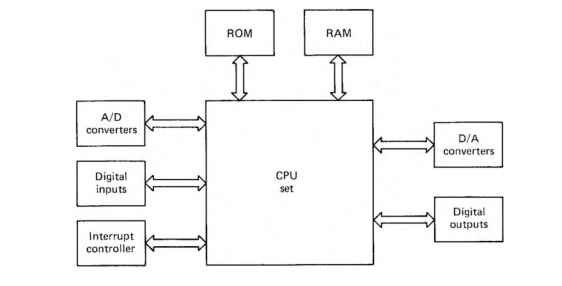
The basic elements of a microcomputer [11-13] are shown in this figure. It consists of the central processing unit (CPU) set, read-only memory (ROM), random access memory (RAM), analog and digital inputs and outputs, and an interrupt controller. The CPU set generally consists of a basic microprocessor, clock generator, bus controller, and bus drivers. It is the heart of a microcomputer and is responsible for unified operation with all elements. It is linked to all elements by the data bus, address bus, and control bus. The data bus width determines the bit size of a computer. The software program consists of a set of instructions for the CPU and is stored in the ROM. The instructions are fetched through the data bus, decoded, and then executed. The program counter in CPU sets up the sequential addresses of the program, which are sent through the address bus. The data to be manipulated by the CPU are stored in RAM or accessed through analog/digital inputs. The processed data are then stored in RAM or sent out through digital/analog outputs. The orderly sequence of program execution can be broken by interrupt signals, which can be generated by hardware or software. A ROM can be mask programmable (PROM) or electrically programmable (EPROM) and ultraviolet light erasable, or electrically programmable and electrically erasable (EEPROM). The read/write memory (RAM) can be static (SRAM) like a flip-flop, or dynamic (DRAM), where the bit information is stored as a charged capacitor that requires periodic refreshing. A flash memory is similar to EEPROM. Dynamic RAM cell size is very small, consumes low power, and is available in large capacity in a chip. The analog signals in the power electronics system are acquired by ADC in a single channel or multichannel (i.e., in a multiplexed manner) with a certain bit resolution and sampling time. Similarly, analog output signals are delivered by DAC in a demultiplexed manner with a certain bit resolution and
sample time. Sometimes, ADCs, DACs, and other dedicated hardware (counters, barrel shifters, etc.) are integrated in the computer. Each computer has a characteristic instruction set in assembly language (AL) mnemonics. The source program in high-level language is compiled into object code for real-time operation. The digital program can be executed quickly by selecting a high-speed computer, by using a more efficient and lower level programming language, by using preprocessing and a look-up table method of execution, or by taking advantage of more dedicated hardware or parallel processing with multiple computers. A few commercial microcomputers/DSPs will be reviewed in the next few figures.